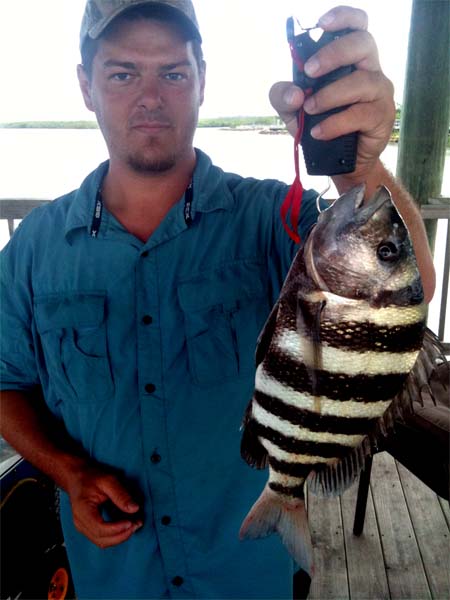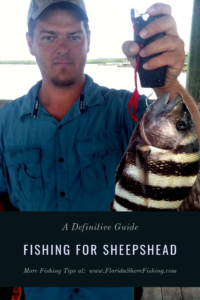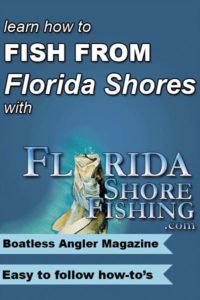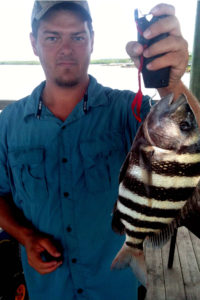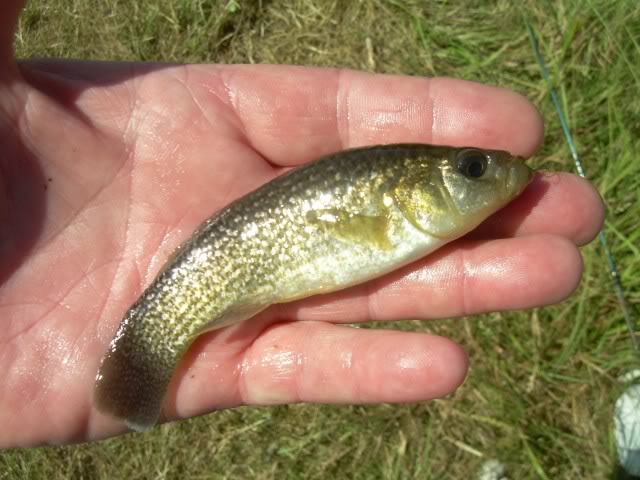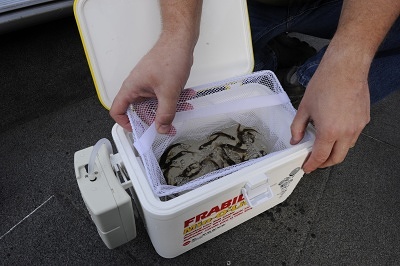Sheepshead are an inshore member of the porgy family. They are a thick, flat fish that has prominent black bars on its white to greyish body, giving the Sheepshead one of its nicknames, the convict fish. Their mouth is full of large protruding teeth that are very similar to a sheep and not too dissimilar from other mammals, such as humans. These teath are one of the easier ways to tell them apart from the very similar looking juvinile black drum.
The spines on the dorsal and anal fins of the Sheepshead are HEAVY and very sharp. Care should be taken to avoid the tips of these fins.
Equipment for Sheepshead
Reel
The average sheepshead is between 2-5 pounds and rarely passes 10 pounds so the size of the fish is not of great concern when choosing a reel. What is most important to consider is that Sheepshead are caught almost exclusively around heavy, jagged cover.
The two best options for reels are saltwater rated inshore spinning reels and baitcasting reels. Because of the cover that Sheepshead are most frequently found around, the reel should be able to handle 10-30lb line, and have enough torque to move fish away from cover quickly.
Rods
Sheepshead will often have a very gentle bite that can be hard to detect if the incorrect rod is used. The ideal rod will have a medium action back bone to give enough power for a good hookset and to move the fish away from cover, while having a light to medium-light tip to give sensitivity.
Select a rod that is matched to the reel and is rated for 10-30 pound line. Make sure that the rod is rated for saltwater because any corrosion on the eyes can lead to an abrasive surface that could compromise the integrity of the line that passes through them.
Line
The best line for fishing for sheepshead is braid in the 12-30 pound class. Braid has very good abrasion resistance, great sensitivity and it does not stretch under a load. These qualities allow the angler to feel the bite, get a good hook set and move the fish away from cover without the line stretching and allowing them to get back to it. The only down side to braided line is that a leader is required.
A leader of 20 pound fluorocarbon line that is about about 10-16 inches should be used. The fluorocarbon line is nearly invisible in the water and has better abrasion resistance and less stretch than monofilament line .
Terminal Tackle
Hooks
Many types of hooks work very well to catch Sheepshead. The 3 most important attributes of the hook is strength, size and sharpness. Sheepshead have incredibly strong jaws, thin, weak hooks can be easily broken by their teeth. They also have relatively small mouths, so a hook small enough to fit in their mouth is required. Most importantly is the hook has to be RAZOR SHARP. Sheepshead have very hard,bony mouths so the hook needs to be sharp enough to penetrate.
Weight
The amount of weight should be determined by the current and depth that the fish are holding at. Use ONLY the amount of weight that is needed to keep the bait at the depth that the fish are feeding. Egg sinkers threaded on above a swivel work VERY well when fishing for sheepshead. Because the line is threaded through them, they do not reduce sensitivity to a bite much, if at all.
Where to Find Sheepshead
Sheepshead can be found in almost any inshore body of saltwater from fall to spring. From far up coastal creeks and rivers to lagoons, bays and just about any water way sheepshead are an abundant and normally easy fish to find. When the water temperatures are high during the summer, the larger fish will migrate offshore, but the smaller fish stay inshore.
Sheepshead spend most of their life foraging on crustaceans. They primarily eat barnacles, encrusted shell fish and crabs. This diet means that they are most frequently found around dock and bridge pilings, rock piles, oyster beds and any other structure that holds barnacles and/or crabs.
When looking for sheepshead, find an area as described above. Look into the water and often times you will see the sheepshead turned sideways in the water to pick crustaceans off the structure. If visibility is bad or fish are just not visible, it is a good idea to find an area of ample structure and chum the area by scraping barnacles off the structure or releasing crushed oysters or crushed frozen shrimp into the water.
Here is an article on How to Attract Sheepshead.
Sheepshead Bait
Fiddler Crabs
The undisputed best bait for Sheepshead is fiddler crabs. These crabs are incredibly abundant, easy to find crabs will almost never be turned down by a feeding sheepshead. Live crabs are by far the best option, but fresh frozen will work well too.
When putting a fiddler crab on the hook, guide the point of the hook up through the bottom of the crab, close to its legs and out the top ensuring the point of the hook is exposed. Male crabs have one large claw that should be removed (it is often grabbed by a Sheepshead and allows them to pull the crab off the hook without ever touching anything other than the claw).
Other Baits
Other baits that work well for Sheepshead are mud crabs (and all other small crabs), sand fleas, live or fresh shrimp, clams and oysters. Any of these baits should be used in a similar manner to fiddler crabs ensuring the point of the hook is exposed.
Sheepshead Fishing Techniques
The most effective technique when fishing for sheepshead is to gently lower a fiddler crab just upcurrent (if there is a current) of where sheepshead are feeding. Allow the current to move the bait into the strike zone and pay close attention to the line and rod for any indication of a bit.
Most bites from Sheepshead are very subtle. They feel like a small “tap-tap” on the end of the line. This tap comes from them biting the bait but not with a quick attacking technique like many other fish do, but with a slow, methodical approach.
Once a bite is detected a rapid set of the hook is required. When using this vertical fishing method, a quick upward swing of the rod is the best hook set technique.
Sheepshead, nicknamed convict fish, are not only called that because of their black and white stripes, but they also earned the nickname because of their ability to steal bait. A success rate of 1 fish per 4 fiddler crabs is a good rate with Sheepshead so do not get discouraged if a lot of fish are being missed. It happens to ALL Sheepshead anglers.
Quick Tips
- Make sure to use ULTRA sharp hooks
- Use a strong upward motion to set the hook
- Bring plenty of bait
- Sheepshead are great bait thieves, do not be discouraged by missed fish
Helpful Links


